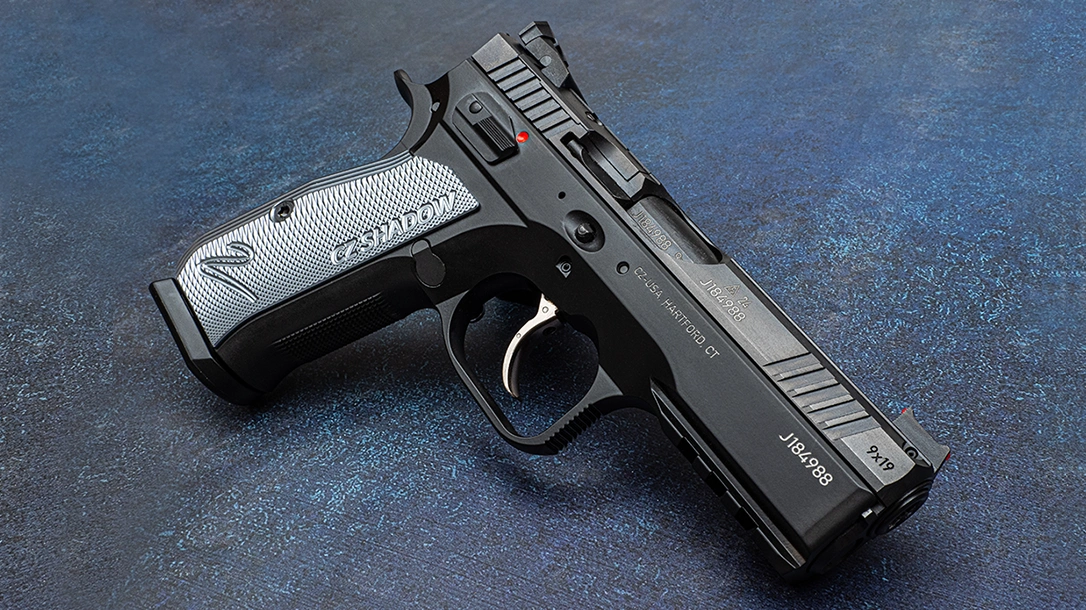In the world of competitive shooting, CZ pistols are at the top of the pack—and for good reason. With fantastic ergonomics, incredible accuracy, and outstanding craftsmanship and reliability, the competition shooters offered up by Česká zbrojovka are the benchmark for ultimate performance. However, CZ is also well renowned for its duty, service, and defensive pistols. They have been used by police agencies, militaries, and private citizens for many decades now. For this review, we take a look at the new Shadow 2 Compact from CZ.
The CZ Shadow 2 Compact
This pistol comes full circle from its roots and marries the best aspects of a competition gun with those of a defensive pistol meant for daily concealed carry. The only question is whether the combination works and makes sense for the average Joe.
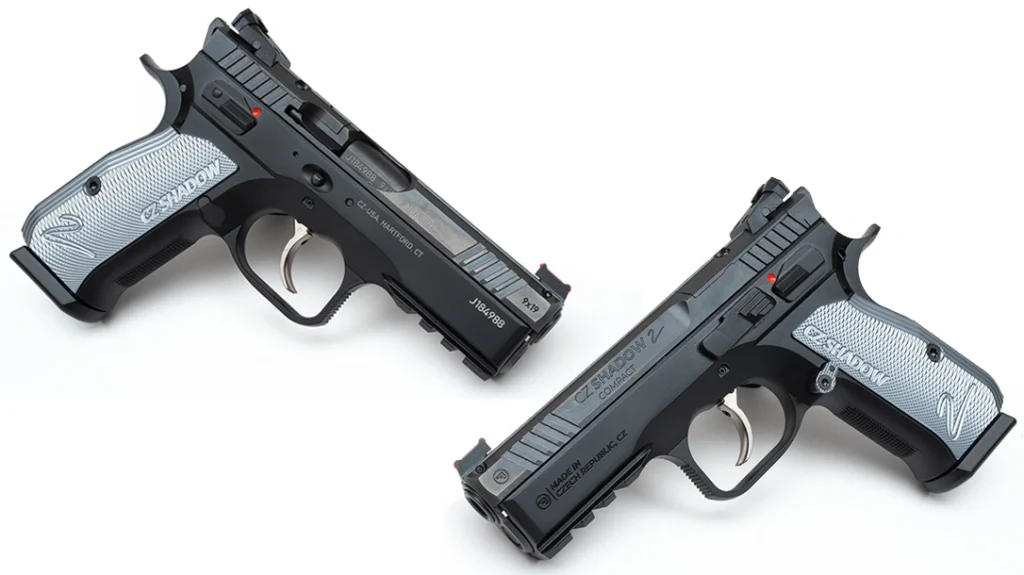
Advertisement — Continue Reading Below
A Little Background
One of CZ’s signature firearms designs during the past century is the CZ 75. Released in 1975, the CZ 75 was one of the first “Wonder-Nine” pistols that included a double-stack magazine.
It was a DA/SA pistol that had the interesting ability to be carried cocked and locked like a 1911. This was due to its frame-mounted thumb safety. In another twist, and unlike most of its peers, the CZ 75’s slide rode inside of its frame rails rather than outside of its frame rails. This allowed for a lower center of gravity that translated to less muzzle flip and a more positive shooting experience.
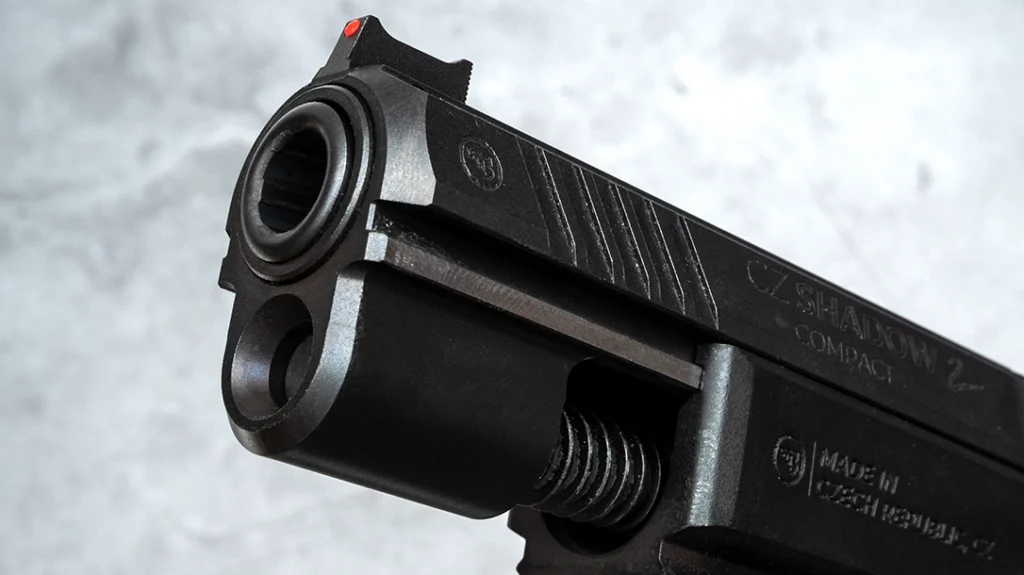
Advertisement — Continue Reading Below
The CZ 75 offered excellent ergonomics and gave the user a higher grip purchase to better control recoil. In some ways, the CZ 75 looks and feels similar to a Browning Hi-Power. Likewise, both share very similar operating systems that include the Browning linkless-cam locking system.
Without getting too deep into the weeds on details, suffice it to say, the CZ 75 quickly became very popular. Since its introduction, it has been issued to more militaries and police agencies around the world than any other pistol.
This background info is important because the CZ 75 design is at the heart of most of CZ’s competition pistols, like the Shadow 2, Shadow TS 2, and the CZC A01. In essence, those competition models are beefed-up variants of the CZ 75.
Advertisement — Continue Reading Below
Specifically, they have features like heavy and full-length dust covers, highly tuned triggers, tighter frame-to-slide fits, more prominent beavertails, more grip and triggerguard relief, extended magazine releases, and so forth.
In short, the competition pistols are refined versions of the CZ 75 optimized for the fast-paced sport of competitive shooting.
Shadow 2 Compact Details
During the last few years, one or more of the engineers at CZ asked, “What if we turned our popular Shadow 2 competition pistol into a compact model for everyday carry?” Well, I’m sure those weren’t their exact words, but you get the gist of the concept.
Advertisement — Continue Reading Below
The Shadow 2 Compact is exactly that, though. It’s a smaller and lighter version of the Shadow 2. For example, instead of using a steel frame like the competition version, the Shadow 2 Compact has an aluminum frame. This lightens the load and makes it easier to carry all day on the hip.
Also, instead of a 4.89-inch barrel, the Shadow 2 Compact incorporates a 4-inch, hammer-forged barrel. Correspondingly, it has a smaller frame for a compact form factor and easier concealability.
Beyond that, though, most of the other details are the same as the competition version. The magazine release, which is reversible for southpaws, is quite prominent and features excellent texturing for easy engagement.
Advertisement — Continue Reading Below
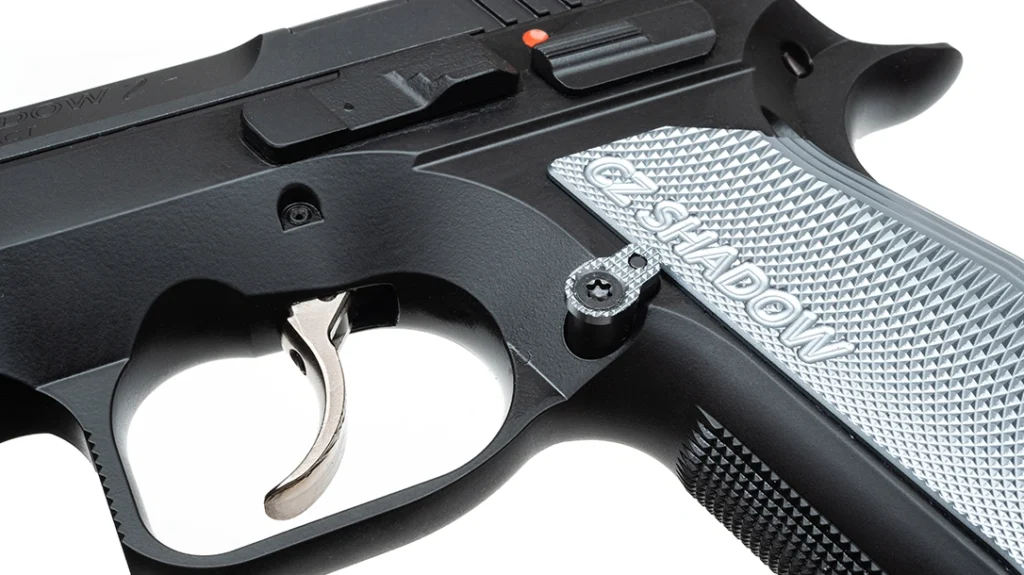
Speaking of texturing, while the Shadow 2 Compact wears checkering on the front and backstraps, it’s not quite as extensive or as fine as the checkering on the full-size Shadow 2. I would assume this was a cost-saving measure. However, CZ also includes checkering on the front of the triggerguard for some of us holdovers from the 80s.
Like the full-size Shadow 2, the Compact sports front and rear cocking serrations for a better grip on the slide for manipulation. Bear in mind, though, that the pistol’s low-profile slide can make it a bit tricky to grasp quickly and confidently.
Advertisement — Continue Reading Below
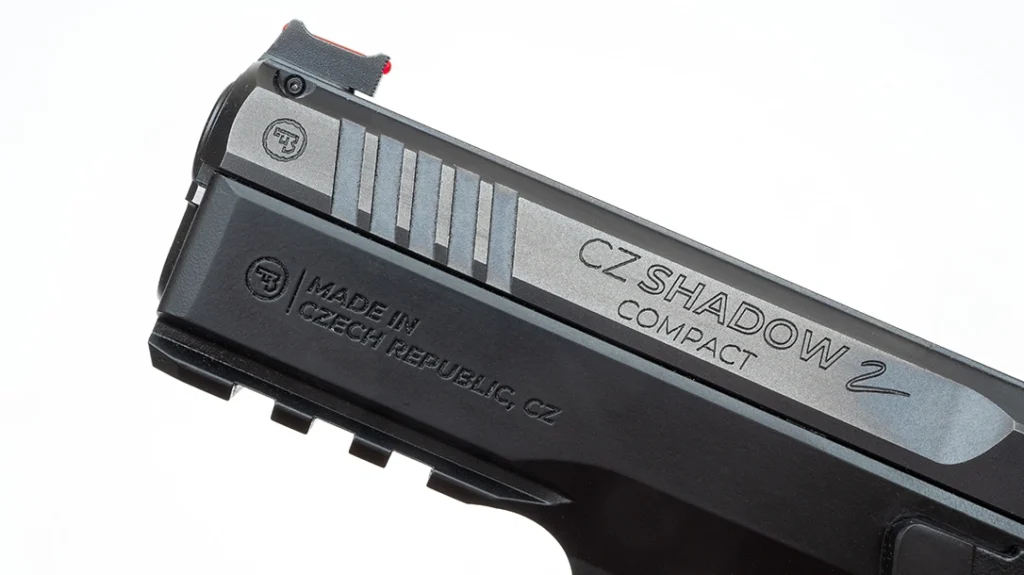
Similarly, the ambidextrous thumb safeties are also of a low-profile variety. This was another intentional design choice to optimize the pistol for daily close-to-the-body carry.
Adding Accessories
Up front, there’s a fiber-optic sight with an accompanying adjustable sight at the rear. The Shadow 2 Compact is optics-ready and the rear sight is part of the slide cover plate. So, if the user decides to mount an optic, then the rear sight will go away.
Advertisement — Continue Reading Below
Multiple serrations on top of the slide, spanning the distance between the front and rear sights, add aesthetic flair and help mitigate glare for the user.
The Shadow 2 Compact offers a proper Picatinny rail instead of the proprietary rail like the full-size model. This allows users mount a wider variety of accessories. Not to mention also reducing the weight even more than the regular rail—especially if no accessory is mounted.
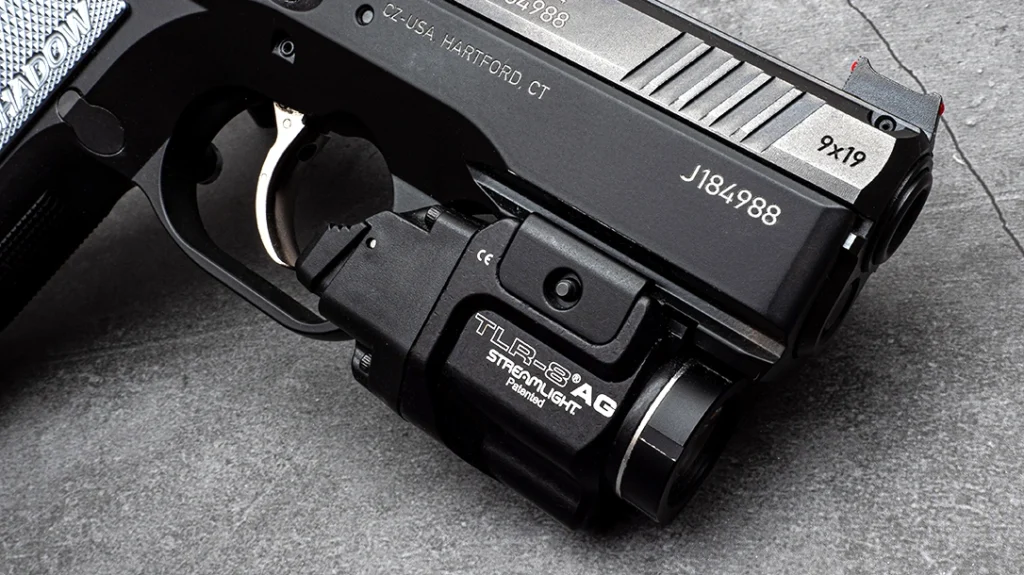
Advertisement — Continue Reading Below
To match the smaller form factor, the Shadow 2 Compact ships with two 15-round magazines as opposed to the 17-round magazines for the full-size Shadow 2. However, the 17-round sticks are compatible with the Shadow 2 Compact.
Top-Shelf Trigger
Of course, one of the highlights of the Shadow 2 Compact is the outstanding trigger, which features a silky-smooth pull. The sample pistol I reviewed had a double-action pull that measured just 8.1 pounds at the break. Even better, the single-action pull broke at just 3.35 pounds on average. This is top-shelf performance, especially for a DA/SA pistol that’s intended for daily carry.
However, as good as the trigger pull and other aspects of the Shadow 2 Compact seem to be, my final determination about the pistol would have to be reserved until I had a chance to put a bunch of rounds downrange.
I also looked for a couple of volunteers to help with the testing. There was no shortage of shooting buddies chomping at the bit to give the Shadow 2 Compact a try.
Me and My Shadow 2 Compact
Testing a quality pistol like the Shadow 2 Compact is always a blast (pardon the pun). However, that testing sometimes reveals little quirks you might not have considered ahead of time. That’s why it’s always important to practice a lot with your carry weapon. It allows you to sort out any issues before things go sideways and you’re caught flat-footed with a problem you didn’t anticipate.
When we tried out the Shadow 2 Compact, it absolutely crushed it with regard to the shooting experience. Thanks to the weight and incredible ergos, the pistol was a dream to shoot.
The recoil response was very soft in the hand, and it shot incredibly flat thanks to our high grip on the pistol and the low-profile slide. Even +P loads that we tried from Hornady and Federal Premium were very easily managed despite the pistol’s compact size.
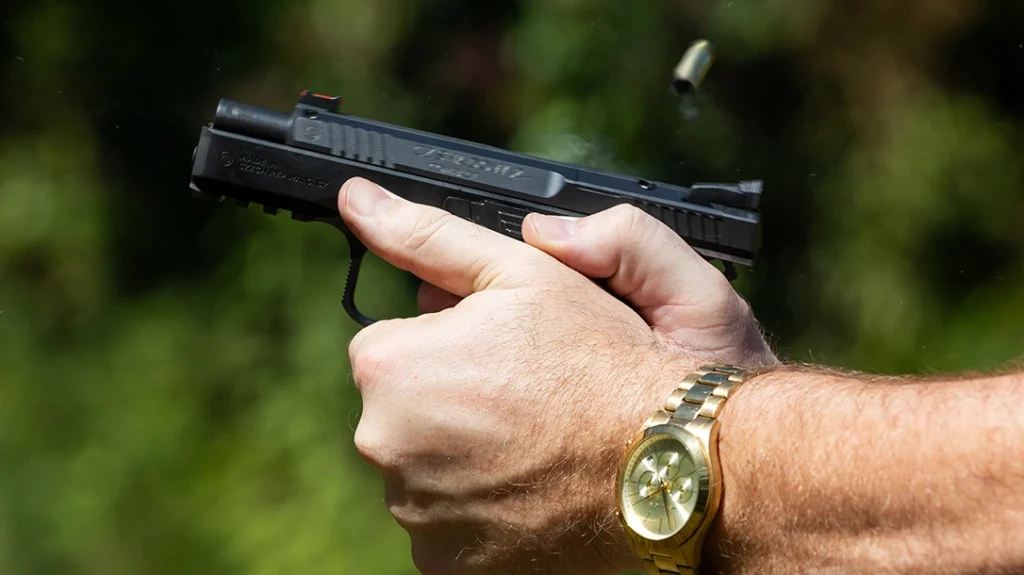
The Shadow 2 Compact’s trigger pull was also incredibly smooth and clean. This helped us to easily stay on target with fast and accurate shots.
Although a couple of the guys used gloves to shoot the Shadow 2 Compact, that wasn’t because of recoil. That was due to the black metal grip frame soaking up sunlight for a few hours. So, it was a touch hot to handle at times with bare hands. Mark this as a disadvantage compared to polymer-framed pistols.
Handling the Shadow 2 Compact
A couple of other things I noticed during our testing had to do with handling and speed to shots on target. First, the front sight post had very sharp corners, and it snagged on material like shirt tails quite easily. This could be a potential issue when drawing from concealment. Snagging on clothing could slow down the draw and put you at a real disadvantage in a defensive encounter.
If I carried the Shadow 2 Compact, I’d figure out a way to round off those sharp edges and corners. Or I’d find another sight option to mitigate this issue.
Another issue we noticed had to do with the low-profile thumb safeties. The Shadow 2 Compact can be carried cocked and locked like a 1911. If carried in that manner, the user has to be able to wipe off the safety quickly during the draw. A couple of us felt they weren’t prominent enough for us to quickly find purchase and flip them off confidently.
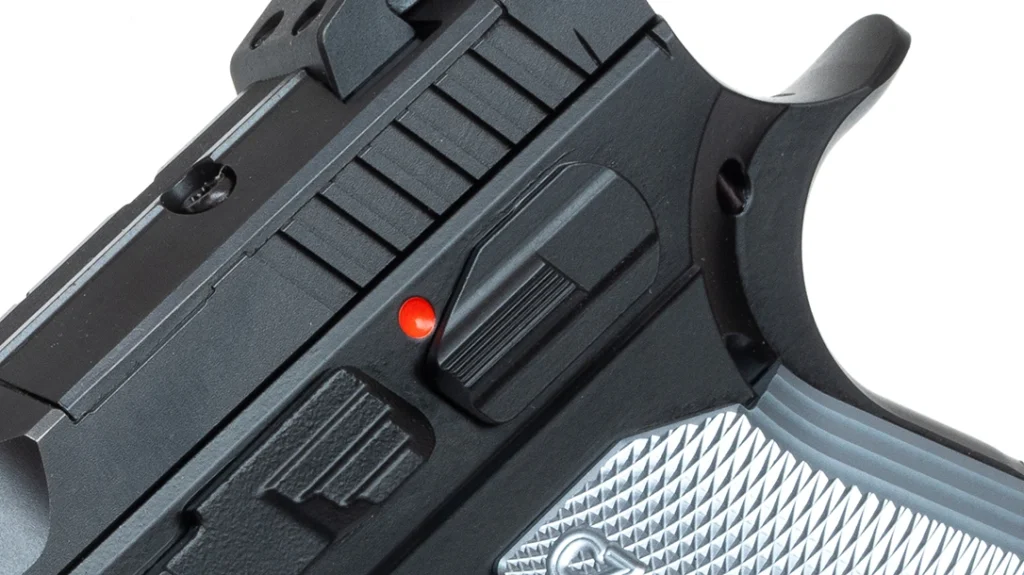
On top of that, the action of the safeties was slightly on the mushy side. They didn’t have that positive pop you get when you snap off the safety on a quality 1911.
This isn’t a huge issue for me since I would just go with the double-action first shot because of the fantastic trigger. However, I know some folks would prefer that 1911-style, cocked-and-locked carry mode. So, this might not be the best experience for them. Of course, your mileage will vary, and it’s a subjective observation.
Sight Picture
The iron sights themselves are quite nice and provide a pretty good sight picture. The fiber-optic sight up front is quick and easy to pick up and shows up nicely against the all-black, serrated rear sight. Correspondingly, the rear sight is drift-adjustable and can be adjusted for elevation as well. The downside is that the rear sight is part of the slide’s cover plate and comes off the pistol if an optic is mounted.
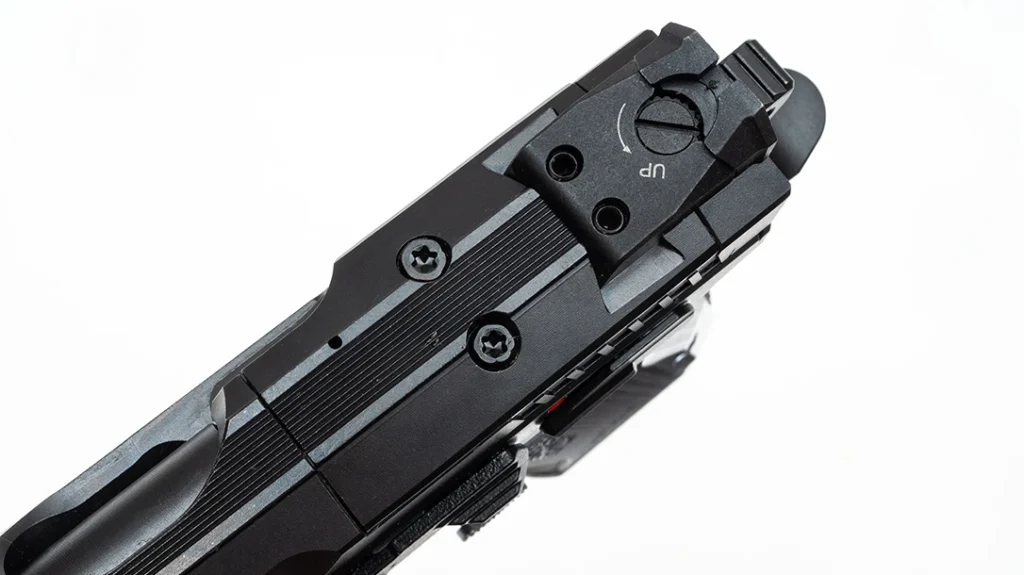
For a competition gun, I guess that’s fine. However, in a defensive pistol, I like having backup iron sights if something goes south with the red dot. Again, that’s just my opinion.
That said, this wouldn’t be a huge issue for me since I probably wouldn’t mount an optic on a pistol of this type and size. However, I know there are plenty of folks who will, so I’m just pointing out something to consider.
Consistent Accuracy
Regarding the pistol’s accuracy during our bench testing, it delivered excellent results across the board with several types of ammunition. Many pistols will prefer one type, brand, or weight of ammo over another. However, the Shadow 2 Compact seemed to like them all.
This is especially noteworthy, considering I did not have an optic mounted during the accuracy portion. My eyes are definitely not what they used to be.
Shooting at 15 yards from a simple pistol rest, we tested five different ammo types for accuracy. The average accuracy for all of the five-shot groups was 1.38 inches. That’s pretty strong, considering the variety of weights, power levels, and ammo types.
For the most part, group sizes ranged from about 1.2 inches to about 1.85 inches, with a couple of outliers at either end.
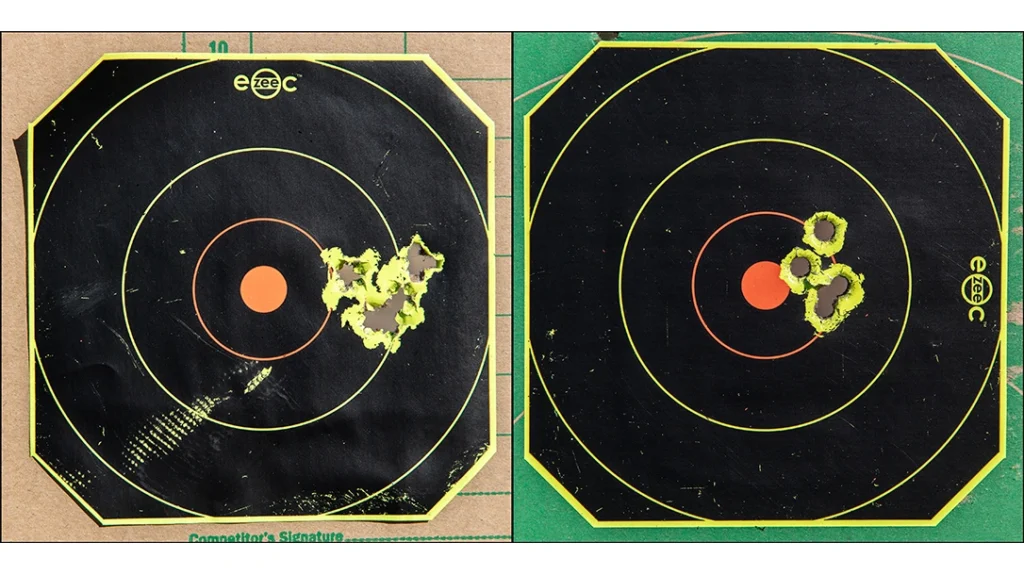
The single best five-shot group was actually a tie between the Lehigh 90gr. XD load and the Federal 115gr. +P P9LFD1 (Lead-Free) load at just .75 inches. I’m not sure if those were happy accidents or not.
I could barely see the little red dot on the target that I was aiming at. But I also shot a 1.0-inch group with the Federal load, so there was probably something to it. Unfortunately, that load (or I) lost the plot, and the third group was well over two inches, blowing up the group average.
Interestingly, I got more consistent group sizes with Remington’s 147-grain Golden Saber Bonded load. So, it had the best three-group average of 1.24 inches.
Keep in mind that these numbers are for this sample pistol only. Results depend on a variety of factors from pistol to pistol. So, you’ll need to find out what works best for you.
CZ Reliability
When it came to reliability, the Shadow 2 Compact turned in high marks there as well. I’ve always had good success with CZ 75-style pistols, and this one was no different.
With a little over 650 rounds fired, the Shadow 2 Compact only experienced a single FTF (Failure to Feed) malfunction. This occurred with Hornady’s 135-grain +P Critical Duty load.
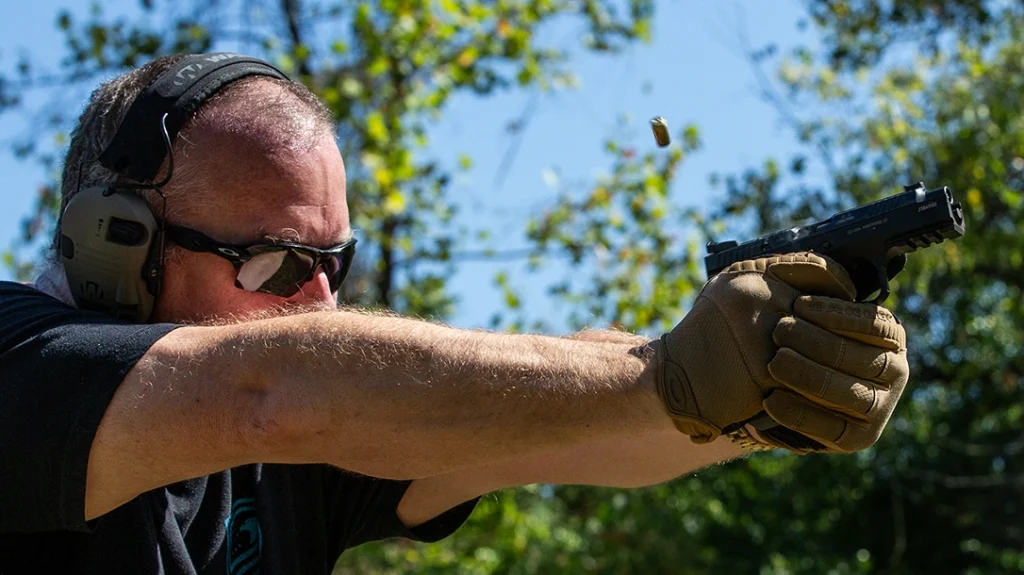
This round has a polymer tip. While it’s an awesome load, I have had a couple of different pistols that have hiccupped a time or two with it. The tip seems to sometimes catch or drag, especially with pistols that have ultra-tight tolerances like the Shadow 2 Compact. That said, this malfunction only occurred once with four 25-round boxes of the Critical Duty ammunition.
It’s possible it was a one-off occurrence with the pistol breaking in or simply a slightly out-of-spec round. It’s hard to guess a cause when it only happened one time. A little more time and testing will let me figure out if there’s an actual issue with that ammo type or if it was just a fluke.
Every other type of ammunition offered to the Shadow 2 Compact fed flawlessly. That’s the typical performance I expect from a top-shelf CZ pistol like the Shadow 2 Compact.
Coming Full Circle
Back before the advent of polymer-framed pistols, people toted around sidearms that had aluminum and—Heavens to Betsy!—steel frames. It took a little more consideration to have a proper belt and holster to support the weight all day. But it was completely doable.
So, having a Shadow 2 Compact with an aluminum frame as an EDC weapon is still a completely plausible alternative. Provided the end user makes proper accommodations with their rig.
The benefit of that extra weight is a very soft shooting pistol that can handily deal with the stiffer recoil of +P loads. Throw in the superb ergos of the CZ 75-style frame design, and the experience is even better.
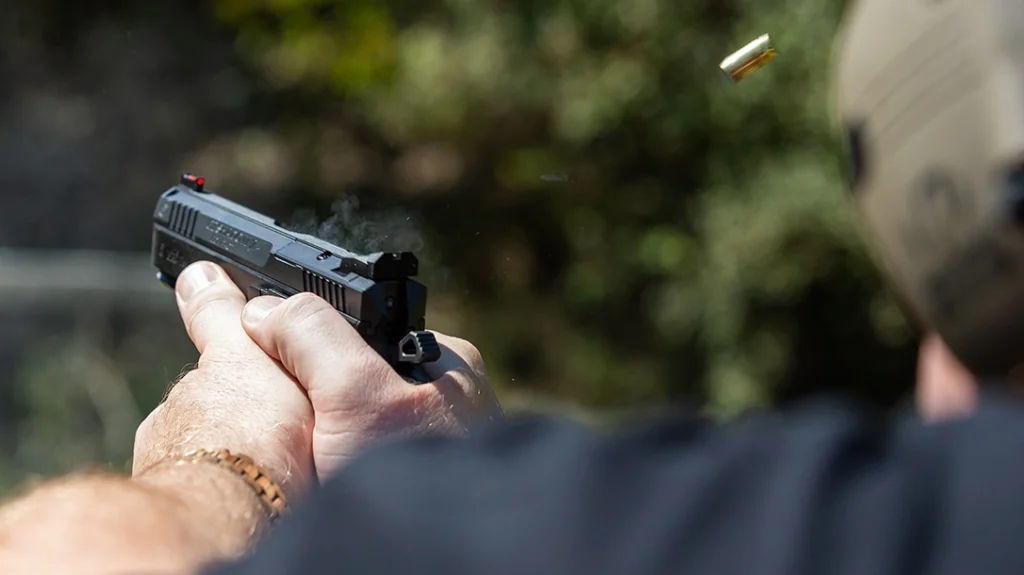
Beyond that, some of the Shadow 2 Compact’s competition features, like the extended magazine release, tighter tolerances for improved accuracy, fiber-optic front sight, and snazzy aluminum grips, add a new dimension of performance and visual aesthetics that you don’t find with your average production carry piece.
As a child of the 70s and 80s, the Shadow 2 Compact’s appeal resides in its DA/SA operating system. I appreciate the added safety of a double-action pull for the first shot. Not to mention the ability to index the hammer with my thumb for safer re-holstering in an IWB rig.
I really like the additional work that’s been done to the trigger group for that glassy-smooth trigger stroke it offers. At minimum, that kind of work is $250 or more from a competent smith. You have to try it to fully appreciate what I’m talking about.
Final Thoughts
The Shadow 2 Compact has a couple of quirks about it that you might have to work around or improve. For example, the sharp front sight and/or the wimpy thumb safeties. However, those are minor issues.
If you’ve ever shot a full-size Shadow 2, then you already know what this pistol is all about. It’s essentially the same performance, just in a smaller and lighter package. I think it’s also interesting that a competition gun (Shadow 2) that’s based on a design for a defensive pistol (CZ 75) be rejiggered to serve as a defensive carry pistol once again.
If you’re already a fan of the Shadow 2 or you’re looking for a visually appealing and high-performing carry piece, the Shadow 2 Compact should be at the very top of your list.
For more information, please visit CZ-USA.com.
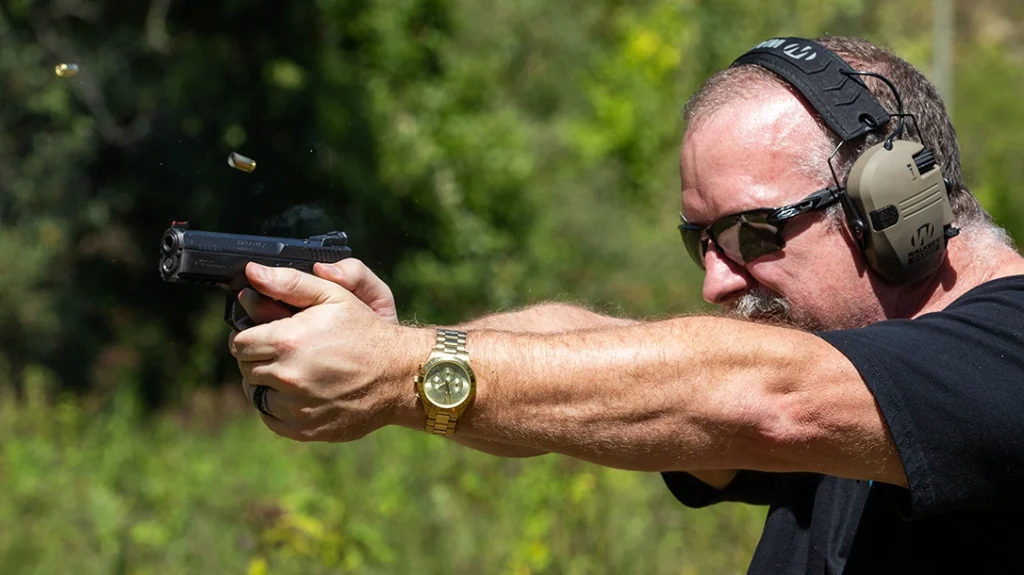
SPECIFICATIONS:
| Caliber | 9mm |
| Barrel | 4 inches |
| Overall Length | 7.5 inches |
| Height | 5.4 inches |
| Width | 1.4 inches |
| Weight | 30 ounces |
| Grips | Duralumin |
| Sights | FO/Rear Adj (on plate) |
| Action | DA/SA |
| Finish | Nitride (slide) |
| Magazine Capacity | 15+1 |
| MSRP | $1299 |
Performance
| Accuracy | |||
| Velocity | Average | Best | |
| Federal 115gr. +P P9LFD1 (Lead-Free) | 1178 | 1.33 | .75 |
| Hornady 115gr. FTX Critical Defense | 1120 | 1.45 | 1.12 |
| Hornady 135gr. +P Critical Duty | 1060 | 1.58 | 1.47 |
| Lehigh 90gr. XD | 1296 | 1.29 | .75 |
| Remington 147gr. Golden Saber Bonded | 960 | 1.24 | 1.18 |
Bullet weight measured in grains, velocity in feet per second from the muzzle by a Garmin Xero C1 Pro Chronograph, and accuracy in inches for three, five-shot groups at 15 yards.
